|
FAQs about Marine Snail
Identification 27
Related Articles: Gastropods, Sea Slugs, Mollusks, Abalone,
Related FAQs: Snail ID
1, Snail ID 2, Snail ID 3, Snail
ID 4, Snail ID 5, Snail ID 6, Snail
ID 7, Snail ID 8, Snail ID 9, Snail ID
10, Snail ID 11, Snail ID 12, Snail
ID 13, Snail ID 14, Snail ID 15, Snail ID
16, Snail ID 17, Snail ID 18, Snail ID
19, Snail ID 20, Snail ID 21, Snail
ID 22, Snail ID 23, Snail ID 24, Snail
ID 25, Snail ID 26, Snail ID
28, Snail ID 29,
Snail ID 30,
& Marine Snails
1, Marine Snails
2, Marine Snails 3,
Invertebrate ID, Snail Behavior, Snail Selection, Snail Compatibility, Snail Systems, Snail Feeding, Snail Disease, Snail Reproduction, Mollusks, Sea
Slugs, Abalone,
|
|
|
Unidentified shell 4/17/14
My friend took this photo in Laguna Beach, Ca and asked
me what it was.
Although I had reef tanks for 10 years, I have not seen anything like
this. Hoping you might have some ideas as to what it is.
Thank you!
Jen Marshall
<Mmm, look like Tube Snail shells: Serpulorbis squamigerus (Carpenter
1857)
Bob Fenner>
|
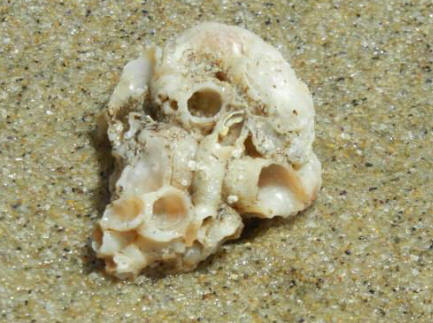 |
|
Gastropod ID 2/19/14
Hello crew.
<Jonas>
My darling wife received this Prosobranchia curiosity as a freebie from our
LFS, but we have not been able to find any significant information on it.
The shell is approximately 4" long, and 3/4" at its widest.
The body and foot of the snail is uniformly white, including it's siphon.
The siphonal canal is well developed, but the siphon itself is short,
appears to have thin diminishing walls, and it's gently notched, oval shape
leads me to believe it is used mainly for respiration.
It's behavior has been hard to observe as it submerges completely in my DSB,
and we have yet to see it emerge in the three weeks it has been living in
our tank. It has moved minimally after submerging.
My main concern is the health of my DSB. Knowing nothing about the diet of
this beautiful animal paired with it's preferred environment I fear
potential, significant damage over time. I know my DSB can handle some
predation, as it appears to be very rich in life for its age. I base this on
the visible density of organisms in the DSB, and the recovery speed of a
severely emaciated Amblygobius rainfordi I received 6 weeks ago by mistake,
which is now plump as a grape from sifting.
<Not much trouble from it here IF the refugium area, DSB is large>
Any information is greatly appreciated.
Thank you for your time and effort. WWM is an incredible resource for us
poor souls who have fallen victim to this wonderful addiction.
Jonas
System info:
Display: 300L "nano" (4 months running)
Sump: 160L w/ 60L refugium section
Live Rock: 20 kg in display, 10kg refugium
Substrate: 4-5" DSB sugar sized
Circulation: 2 x 1800-12000L/H closed loop w/ 4 outlets per pump
<Looks to be an Auger... Terebra sp.... or maybe a Mitra sp.:
http://www.wetwebmedia.com/snailidfaq7.htm
Bob Fenner>
|
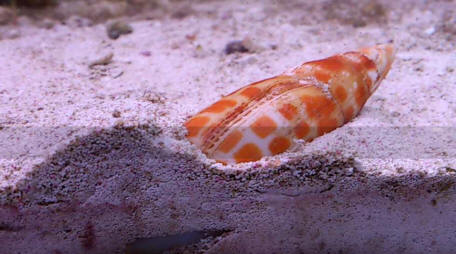 |
Snail id
2/6/14
Hi Bob, I found this snail and was hoping you could help me identify it? I
think it belongs to Olividae family! It's not a con snail is it ? Sorry
about the poor quality of the photo I will send some more!!
<Can't make out much here... Does have the shell-shape of an Olivid... Have
sent to LynnZ for her input. Bob Fenner> |
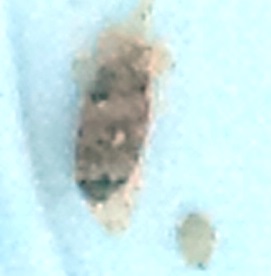
Re: fw: Snail id 2/7/14
Hi Bob, unfortunately I just can't see enough of the shell to be able
to offer a solid ID. Offhand, it looks like an Olivid of some sort,
but I'd want to see another couple of photos to rule out a Conid. Also, I
didn't see anything regarding size, but if the shell is small it could be a
Marginellid (most are <15mm long). At any rate, I'd love to see any
additional photos that come along! Take care, Lynn
<I concur and pretty much responded the same. We'll wait to see if there's
follow up, better pix. Cheers, BobF>
|
|
What is this? 1/7/14
I found this eating my star polyps.
<not>
Any idea what they are?
Linton
<Ah yes; Limpets... see WWM re. Bob Fenner>
|
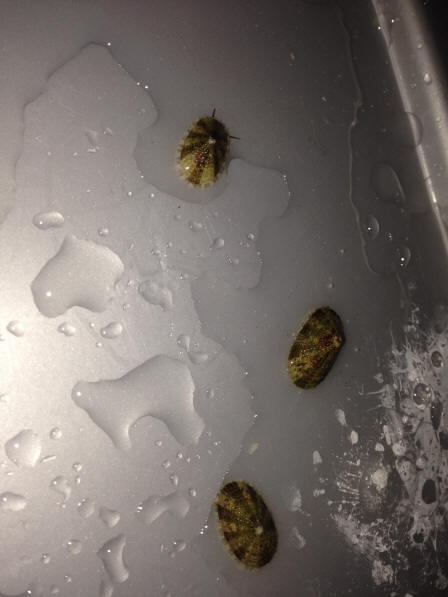 |
|
Hi Bob, I was just wandering if you could I.D this
hitchhiker? 12/17/13
I removed it
from the tank but will there be others? It looks like a small cone sail!
<.... can barely make this/these out. See WWM re Snail ID (the numerous
FAQs files)>
|
.JPG)
.JPG) |
|
ID please 11/7/13
<Scutus. Bob Fenner>
Hello, I have searched the Internet and WetWebMedia trying to ID this
organism without any definitive results. It arrived on a rock that is home
to a Feather Duster I purchased and now resides in a quarantine tank until I
learn more about it.
Originally, I thought it may be a Stomatella snail except that it is very
thin and about the size and shape of a .50 piece. It may still be a variant,
but, does not resemble the others in my tank. More specifically, it is a
very flat, slow mover, which has two pronounced feelers coming out of what i
would presume to be the head, and has a harder spot - that is cream colored
- in the center. The underneath "foot" is cream colored also.
Is this reef/invertebrate/fish safe?
Any insight would be much appreciated.
Right side up
Upside down
Thanks
Dennis
|
 |
|
Please help with snail IDs!
11/5/13
Hi,
Found these guys in my reef aquarium's refugium.
<Mmm>
The large one I probably bought as a "Nassarius".
<Not>
However, it doesn't glide quickly.
They all hang out in the middle of the glass or on powerheads, and not
in the sand.
We may be dealing with several kinds here. Please help with IDs before
they die or I just throw them back in!
Thanks, Meir
<Search on WWM re Fasciolariids... Bob Fenner>
|
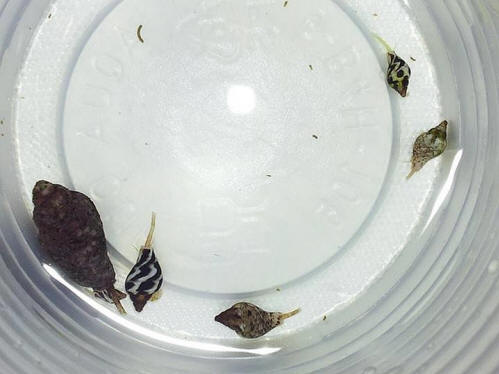 |
|
Snail ID: Possible Limpet – 8/29/13
I found this "little" guy in a reef system and was wondering what it
might be. He flattens out like a limpet and looks like a giant limpet.
<What I can see does look akin to a limpet but there are a couple of
other possibilities as well. I’d need to see a detailed photo
showing the top surface of the shell in order to have a better shot at
an ID.>
When flattened out it is almost 2" in length.
<What size is that actual shell? In the photo, it looks just a bit
larger than the penny (= ¾”), so I’m guessing it’s close to an inch
across. Is that about right? Also, is there a hole in the
top of the shell? Any and all information helps! In
the meantime, do look through our limpet FAQ’s for more information and
photos, starting here:
http://www.wetwebmedia.com/MolluscPIX/Gastropods/Prosobranch%20PIX/Limpets%20Scutus/LimpetF1.htm
Take care, Lynn Z>
|
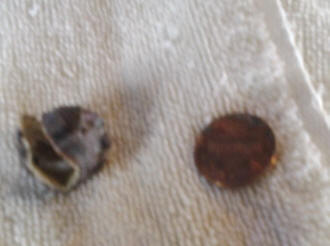 |
Re: Snail ID: Possible Limpet
- Nope: Polyplacophoran/Chiton! 8/30/13
In that picture, the snail is curled up. The top of the shell is sectioned
line armored scales to allow the snail to be flexible.
<Gotcha, thanks; that changes everything!>
When stretched out it is about 2" in length and 1" wide. Also, it was nearly
impossible to get off the side of the tank. It can move at about the speed
of a Turbo Snail.
<Sounds like you’ve got a beneficial grazer called a Chiton/Polyplacophoran.
Please see WWM for more information, starting here:
http://www.wetwebmedia.com/chitonfaqs.htm?h=
If that’s not what you have, do send along a few more photos and we’ll give
it another go! Take care, Lynn Z> Re:
Snail ID: Possible Limpet - Nope: Polyplacophoran/Chiton!
8/31/13
Ah, very good thank you for your help.
<You’re very welcome.>
One question further. I know that they are mostly herbivores, however there
are a few predatory species.
<Yes, there are – as well as others besides. Chitons run the gamut
from being herbivores, detritivores, carnivores or even omnivores.
Thankfully, the hitchhikers we tend to run across are beneficial,
herbivorous, hard-surface grazers of diatoms and/or coralline algae.
The biggest concern with these is the possibility of them leaving rasp marks
in an acrylic tank. It should be noted, that even these herbivorous
species can be incidental consumers of the various tiny critters (‘pods,
worms, and such) they run across, so in essence, they could technically be
considered omnivorous. The good news is that they’re not actively
trying to find and eat the critters, they just happen to be in the way while
grazing. As for the true carnivores, they consume a variety of
foods from various ’pods to Foraminiferans, Ostracods, worms, sponges,
crustaceans, fishes, etc.. The smaller, slower prey items are
generally obtained by simply mowing over and consuming any that are in the
Chiton's path, while larger, faster prey can typically be either ambushed,
or enticed and trapped, by use of an enlarged anterior girdle area. >
I'm guessing mine is not of the predatory variety due to the lack of an
enlarged mantle?
<That’s right – at least it’s not one of the big-time predators, like those
in the genus Placiphorella. There are other carnivorous Chitons,
however, that do not have that enlarged anterior girdle. That being
said, I wouldn’t worry a bit about your individual. I’ve never seen,
or heard of, any hitchhiking Chiton that posed any sort of threat to major
livestock. I say enjoy it for as long as it’s around! By the way, I
have a couple of links for you that you might find interesting/helpful.
The first is a good basic article while the second is a paper that relates
to diet. It’s probably more than you ever wanted to know about what
Chitons eat, but it’s interesting!
http://biology.fullerton.edu/deernisse/pubs/Eernisse_07_chitons_Tidepools.pdf
http://mollus.oxfordjournals.org/content/70/3/225.full.pdf
Take care, Lynn Z>
|
|
flatworms in reef tank? 8/17/13
Hi,
<James>
I've noticed what appears to be white flatworms with little antennas
<Mmm, Platyhelminths don't generally have "antennae">
moving across the sides of my tank. I have not seen them on any of the
live rock just the glass, so I have been taking them out when I can.
Today I noticed a one larger one and included a picture. From what I can
gather on-line some of these things are VERY BAD and some or so-so
(won't destroy your tank). I have a 165 gallon with Fiji live rock going
through the cycling process (been about 4 weeks now). They don't look
like the rust brown flatworm but then again I am only seeing the
underside of them which is white. I'm waiting for the bad news ;-(
Thanks for you help!
<I wouldn't over-react. Likely this/these are of little to no matter;
and will likely "pass" in time on their own. If it were me/mine, I would
do nothing (other than read on WWM re Flatworms period) for now. Bob
Fenner>
<Oh! In enhancing your pic; this appears to be a Gastropod... See WWM re
Stomatella. BobF> 8/17/13
|
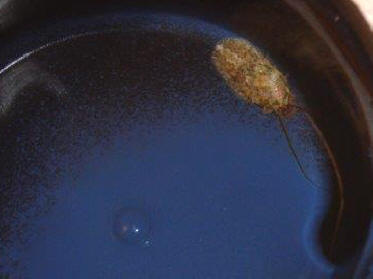
Re: flatworms <Stomatella)> in reef tank? 8/17/13
Thanks Bob! I'll add them to my CUC and leave them alone :-)
<Ah, good. Are beneficial. B>
|
|
little cowry?– 6/24/13
I found this guy clinging to my carnation coral.
<Neat!>
Was wondering what he is and if he is a good hitchhiker or not. Please let
me know what you think. He has an awesome orange and white shell.
<Mmm, how large is this animal? This looks to be a Stomatella varia;
nocturnal algae grazers. Bob Fenner>
|
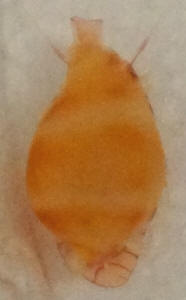 |
Re: little cowry?– 6/24/13
Hello again,
<Annie>
It is about the size of a pea. I have quite a few stomatellas, but this one
has a full shell and not just a cap and also the underside of his shell
looks like a cowry shell (has the slit with ridges along the sides).
<Mmm, well... this could be a juvenile Leviathan cowry... we'll have to
wait and see as it grows! BobF>
Re: little cowry?
Are there any snails that have this coloring that are related to the bumble
bee snails? Upon closer inspection the shell is shaped like that more than a
cowry I think?
Thanks!
Andrea
<<Sending to LynnZ...>>
Re: little cowry?– 6/24/13
Thanks Bob - I'm on it! Take care, Lynn
<Thank you Lynn. BobF>
Little Cowry? Probable Predatory Ovulid – 6/24/13
<Hello, Lynn here this evening.>
I found this guy clinging to my carnation coral.
<That’s a great bit of information, thanks.>
Was wondering what he is and if he is a good hitchhiker or not.
<If it’s what I think it is, it’s not, at least as far as your
Dendronephthya/carnation coral is concerned.>
Please let me know what you think.
<I would love to see a detailed photo of this little fellow (one from above,
one from below), but I suspect that it’s a Dendronephthya predator in the
family Ovulidae and I would remove it asap along with any others like it.
Ovulids (Egg/“false” cowries) are similar to “true” cowries (family
Cypraeidae) in appearance and are predators of cnidarians (some specializing
in Dendronephthya spp.). Judging by what I can see of your individual’s
shell and foot, it appears to be something in the subfamily Prionovolvinae,
which includes a number of genera. Unfortunately, these snails can
vary to a surprising degree in shell and mantle coloration within each
species, so identification can be a challenge. If you wish to pursue
an ID (and are unable to send detailed photos) I would recommend beginning
with the genus Habuprionovolva (see link below), then move on to the other
genera within the subfamily (Diminovula, Prionovolva, etc.). Please
see the following links for comparison/more information:
Habuprionovolva aenigma:
http://www.gastropods.com/7/Shell_10247.shtml
Subfamily Prionovolvinae photos begin about 1/3 down the page (each photo is
a link to more info/photos):
http://www.gastropods.com/Taxon_pages/TN_Family_OVULIDAE.shtml
Photos of live Habuprionovolva spp. with mantles extended:
http://science.naturalis.nl/research/people/cv/reijnen/habuprionovolva>
He has an awesome orange and white shell.
<He certainly does; cowries and Ovulids have beautifully glossy shells.
What’s interesting about these guys is the degree to which they match their
host’s coloration and texture, thereby protecting themselves from predators
and unsuspecting hobbyists! Oddly enough, it’s not the shell that’s key to
their camouflage, it’s the extraordinary coloration and textures of the soft
mantle tissue that extends up and around the sides. This enables the
animal to practically disappear along the branches of its prey. These
really are beautiful animals. It’s just a shame that they prey on a
beautiful coral that in itself can be very difficult to keep! Please
let me/us know if there's anything else I/we can do to help. Take care, Lynn
Z>
Re: Little Cowry? Probable Predatory Ovulid – 6/24/13
<Hello Andrea, Lynn here again!>
Are there any snails that have this coloring that are related to the bumble
bee snails? Upon closer inspection the shell is shaped like that more than a
cowry I think?
<Do look at the Ovulids mentioned in the previous mail and see if anything
there looks like what you have. If I’m way off base, let me know and
we’ll give it another try!>
Thanks!
<You’re very welcome!>
Andrea
<Take care, Lynn Z)
Re: Little Cowry? Probable Predatory Ovulid – 6/24/13
Yes, it is the first species that you sent a photo link of.
<Yay!>
Too bad it's a predator snail...
<No kidding, it’s a shame.>
Maybe I'll have to set up a pico tank for this little guy, too pretty to let
die. Maybe I'll buy a few of these carnation corals and see if he'll
survive.
<That could get expensive, but if the coral was flourishing, perhaps one
small snail wouldn’t do enough damage to kill it off entirely.>
Thanks!
<It was a real pleasure!>
Annie
<Take care and good luck! Lynn Z> |
|
What are these? Likely Stomatellid - 1/29/13
Something eating my Zoas. I did find a sundial snail,
<Yikes, definitely remove it and keep an eye out for others.>
…but I have these slugs with a bluish back also. Should I yank ‘em?
<Hmm, well I’d need to see the top of the snail to be sure, but it appears
to be a harmless, Stomatella sp. of some sort. I would definitely
leave any of these in place as they’re beneficial herbivorous grazers that
reproduce easily in captivity. For more information, please enter the term
“Stomatellid” in our search engine:
http://www.wetwebmedia.com/Googlesearch.htm
More info here:
http://wetwebmediaforum.com/showthread.php?176-Critter-of-the-Week-Stomatella-nails&highlight=stomatellid
Hope that helps! Take care, Lynn Z>
|
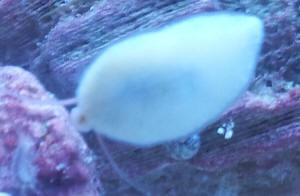 |
|
Snail I.D 12/26/12
I recently found this little mollusk crawling through my tank. As I was
unsure of what it was. I removed it from the tank for now. It is about
an inch long, flat(ish), and has a girdle of (skin or whatever) around
it. No hard outer shell is apparent but has two feelers at its head.
Please help.
<Mmm, there is a shell, internally... this appears to be a Scutus... see
here:
http://wetwebmedia.com/MolluscPIX/Gastropods/Prosobranch%20PIX/Limpets%20Scutus/LimpetF1.htm>
A harmless limpet. Bob Fenner>
|
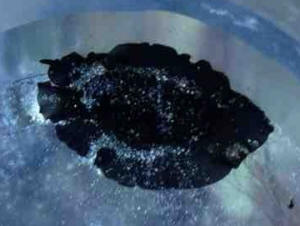
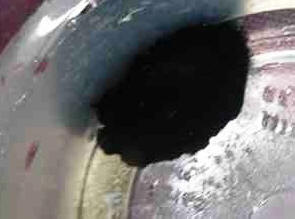
Re: Snail I.D 12/27/12
Thank you very much. Added the guy back to the tank.
<Ah good. BobF>
|
|
Marine Snail Identification? Marginellid, Volvarina
sp. – 12/12/12
Hello WetWeb Crew,
<Hello Wendy, Lynn here this evening.>
Can you identify the marine snail in the picture I’ve attached?
<Yes indeed, I’ve seen this snail before. It’s a Marginellid
(family Marginellidae) in the genus Volvarina.>
I have many of these infesting my deep sand beds and live rock. They are
approximately 1/4 inch in length. I have never had any adult snails in
the tank which resemble these but do assume they are babies.
<Actually there are Volvarina species that, as adults, measure less than
1/4” so you’re more than likely seeing the full-grown versions.>
Is it a Conus Magus? I can see they have proboscis, and think I may have
seen some other ‘headgear’ waving around....
<Nope, it’s definitely not a cone snail. Take a look at the FAQ
titled “Re: Unknown Critter ID? Snail: Marginellid, Volvarina sp. --
8/24/10” at the following link for more information/photos:
http://www.wetwebmedia.com/SnailIDF24.htm?h= >
Thanks,
<You’re very welcome.>
Wendy from Michigan
<Take care, Lynn Z from Washington State>
|
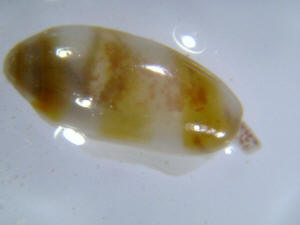 |
|
Help in Invert ID
– 11/20/12
Hello Awesome WWM Crew!
Can you please help me identify this hitchhiker in my tank, and is it safe
to keep in a reef tank? Kinda like its appearance and I'm thinking of
keeping it :)
Thanks!
Gabe M
Can't make out what this is from your blurry pix Gabe. Can you provide some
that are better resolved? Have sent along to LynnZ for her go. Bob Fenner
|
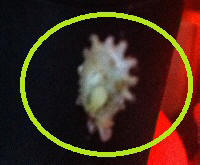
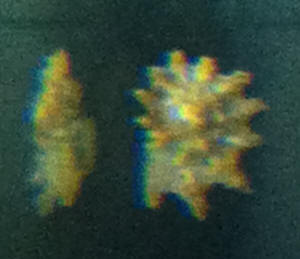 |
|
Re: Help in Invert ID
– 11/20/12
I'll try, the little bugger is a bit hard to find,
<Do send along a physical and behavioral description as well please>
just managed to snap this shot with my phone last night when it was in
broad *cough* daylight.
<A small digital camera is much better>
Will send a better one when I see it again.
Thanks, Bob.
<Welcome Gabe. B>
Re: Help in Invert ID
11/20/12
Thanks Bob, it looks like a Lithopoma/Astraea species of some sort.
I'll send Gabriel a reply (through WWM) ASAP!
Take care,
-Lynn
<Ahh, thank you Lynn. B>
Help in Invert ID – Turbinid and Possible Whelk – 11/20/12
Hello Awesome WWM Crew!
<Woohoo! Thanks, and hello to you too!>
Can you please help me identify this hitchhiker in my tank,
<It appears to be a harmless Turbinid (family Turbinidae) snail of some
sort. Could you tell me where it came from originally? Also, if you
could send along a more detailed photo (or two) and tell me the approximate
size that would be most helpful. Please see the following link for
examples of turbinids (each photo is a link to more information and photos):
http://www.gastropods.com/Taxon_pages/TN_Family_TURBINIDAE.shtml#TURBINIDAEASTRAEINAE
>
…and is it safe to keep in a reef tank?
<If it is indeed a Turbinid, then yes, it’ll be fine. That is, it will
consume film algae, diatoms and the like, and will not pose a threat to any
corals or other livestock. All in all, it’ll be a terrific addition to
your clean-up crew. I’m actually more concerned about the snail seen
at the bottom of image 4111. It looks a lot like a whelk, a common
hitchhiker on live rock from Florida that preys on other snails and small
invert’s. Do send along a detailed photo or two and I’ll do my best to
confirm whether it could be a problem.>
Kinda like its appearance and I'm thinking of keeping it :)
<Yep, it’s a beauty alright!>
Thanks!
<You’re most welcome! Take care, Lynn Z>
Re: Help in Invert ID
11/21/12
Hey Bob,
<Big G!>
I think I know what snail it is, Lynn gave me an awesome link to help me ID
it.. from the looks of it, it's Bellastraea squamifera. Definitely a keeper
:D
Thanks, Bob
Gabe
<Cheers, BobF>
Re: Help in Invert ID – Turbinid and Possible Whelk – 11/21/12
Hello Lynn,
<Hello Gabe!>
Thank you for your reply and that really useful link.. definitely going to
my bookmarks :D
<You’re very welcome; I’m glad I was able to help.>
From there, I think it's Bellastraea squamifera, looks exactly like it, a
bit different on its shade but the resemblance is uncanny. It's about
a quarter of an inch across & flat when viewed on the sides. Awesome if it
is! :D
<Yes indeed! It’s definitely a pretty little snail, but time (and maybe a
bit more info) will tell regarding the ID. Complicating the issue is
the fact that your individual is most likely a juvenile and its shell may
significantly differ from than of an adult. We really need to find out
where the snail originated in order to have the best chance at a solid ID.
If it arrived on live rock, where was it from? At any rate, even
without that knowledge, I can tell you that your snail does not pose a
threat to other livestock so I say enjoy! For what it’s worth, here’s
another potential candidate (Astralium phoebium, aka the Long-spined Star
Snail):
http://www.gastropods.com/3/Shell_323.shtml >
I actually bought the snail at the bottom of the picture - four of them, LFS
said they're Nassarius. So far, they've been doing a good job at
eating detritus and left over food. Should I be concerned?
<Well, if it’s a true Nassarius, no. Just keep the snails well-fed,
since they’re mostly scavengers, and they should do just fine. The
trick is to find out whether they’re really Nassarius spp. snails or
something else entirely. Just out of curiosity, do your snails
look like the ones (Ilyanassa obsoleta, aka the Eastern Mud Snail) at the
following site?
http://z14.invisionfree.com/Conchologist_Forum/ar/t2240.htm?
If so, do use our Google search engine for more information and/or contact
me. Last but not least, please see the following link for more
information regarding Nassarius spp. snails, including how to recognize them
by a characteristic groove in their shell (start about half-way down the
page): http://web.archive.org/web/20010410073108/http://www.animalnetwork.com/fish/library/articleview2.asp?Section=&RecordNo=166
>
I'm planning to buy some more CUC inverts and I definitely don't want them
eating those O.O
<No, indeed!>
Thanks!
<You’re most welcome!>
Gabe M
<Take care, Lynn Z>
Re: Help in Invert ID – Turbinid and Possible Whelk – 11/22/12
Howdy Lynn,
<Howdy Gabe>
I'm afraid there's no way to really know where the rock came from.. But I'm
in the tropics so the Liverock would also be from the surrounding regions,
if that's any help at all.
<No worries, suffice it to say that it’s a beautiful little snail and
harmless to boot!>
For the other snail, it doesn't look like any of those Ilyanassa obsoleta
ones.
<Good, those are a cooler-water species that have been sold online and in
some of the LFS in the US as a Nassarius spp. (but they're not!), so I
thought I’d cover that base just to be sure. If you’re outside of the
US in the tropics, then chances are good that your LFS won’t be offering
those snails.>
Although, it doesn't look quite exactly like the Nassarius spp snail either.
I'll check later if they have that groove in their shells.
<Sounds good. Do let me/us know if you need any more assistance with
the ID.>
So far they have been laying eggs like crazy in the tank (same in appearance
with the Nassarius eggs when I searched).
<Gotcha>
And I read somewhere, and I don't know how true, that snails laying eggs are
indications that they are eating well?
<That’s what I’ve heard/read as well.>
I did notice a hitchhiking brittle star with missing legs though, and
another hitchhiking clam that mysteriously got emptied out.
<It happens. Hitchhikers can really get banged up and exposed to all
sorts of stresses during collection, transit, and curing. Regarding
the clam, sometimes they just don’t have enough food, especially in a new
tank, to sustain them so they die and the scavengers feast. >
They should not suppose to eat anything still alive right?
<Well, Nassarius spp., snails are scavengers that are attracted to dead
and/or damaged/dying tissue so healthy animals are safe while wounded
individuals may well be targeted (especially if there’s not enough available
food otherwise).>
I mean, I've seen them "walking" over the YW goby
<Do I ever love those comical little fishes!>
..and they literally smother him all over, tumbling the goby sideways,
turning him upside down.. in other words, really inappropriate ways :D .
The goby doesn't mind them at all, just lets them do as they please with
him.
<Heheeee! That is one tolerant little goby!>
If they ate the clam/star, I would think they would do the same with the
goby seeing that the fish isn't making any effort to escape their slimy
molestations :D
<Heeee, yes indeed! Any opportunistic predator worth its salt would
never turn down a meal that just sits there and allows itself to be mobbed!
Obviously the goby doesn’t perceive the snails as any sort of threat.
I would just keep an eye on the situation, keep the snails well-fed, and
only remove if/when necessary.>
Thanks,
<It was my pleasure, Gabe. Again, if there’s anything else we can do
for you, just let us know.>
Gabe M
<Take care, Lynn Z>
|
|
|

